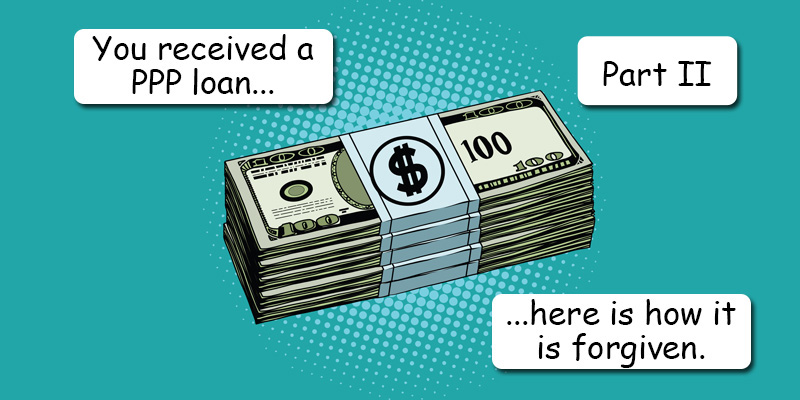The Small Business Administration (SBA) has released the Loan Forgiveness Application, which has provided answers to many previously-vague conditions of forgiveness. One problem is that for many, these instructions come towards the end of their eight-week loan proceeds spending and may be too late. I saw one article state that the loan application failed to provide instructions as to how to build a time machine to go back in time to correct what might have already been done. We may see a spike in Delorean resales!
Rather than repeat what I have provided in the first article
https://blog.paymaster.com/sba-paycheck-protection-program-ppp-loan-forgiveness/ , I will just cover the new developments.
The eight weeks of spending starts on the loan disbursement date (the day the funds are received). The easiest way is to count 55 days after that date. There is an ‘alternative payroll covered period’ when weekly or biweekly payroll schedule borrowers can elect to calculate their eligible payroll costs by using the eight-week period that begins on the first day of the pay period that follows the receipt of their funds. This alternative period is for ‘payroll costs’ ONLY.
Costs must be incurred and paid within the eight weeks, but there are exceptions. Payroll costs incurred, but not paid during the last pay period of the eight weeks or alternative period, are eligible for forgiveness if paid on or before the next regular payroll date. This means if your eight weeks end on June 14, the same day your biweekly pay period ends and your check date is five days later on June 19, that payroll counts towards forgiveness. Non-payroll costs must be paid during the original eight-week covered period OR incurred during that period and paid on or before the next regular billing date, even if the billing date is after the eight-week covered period. This appears to mean that if you receive the funds on May 15, and you owe two months of back rent/utilities and pay the bill after that date, it will count towards forgiveness.
Payroll and non-payroll costs appear to be in line with what was previously known, although there is a new exclusion. The amounts paid to owners, general partners, or self-employed individuals are capped at the lesser of $15,385 OR the eight-week equivalent of their compensation for 2019. This prohibits an owner from reducing their employee compensation and increasing their own compensation.
The biggest help the application provides is guidance on how to count a Full-time Equivalent Employee (FTEE). We are actually provided with two different methods to choose from. Just be sure you are consistent and use the same method for pre-COVID-19 and covered period counting.
Method 1 is to take the total hours (exclude overtime hours) worked in a period of time and divide by 40 hours for each week in that period of time, and add to that 1.0 for anyone who is paid a salary, since they do not have hours. Here is an example: Let’s say you have a biweekly payroll with 2 salaried employees and 13 employees that were paid 842 hours (excluding the OT hours):
- 842 hours / 80 (two 40 hour weeks) = 10.5
- 2 salaried employees X 1.0 = 2.0
- Total FTE count (10.5 + 2.0) = 12.5
Method 2 is the simplified method where you can assign 1.0 for employees who work 40 hours or more per week, and 0.5 for employees who work fewer than 40 hours per week. Let’s use the same example as above, assuming all 13 hourly employees only work 35 hours per week:
- 13 employees X 0.5 hours = 6.5
- 2 salaried employees X 1.0 = 2.0
- Total FTE count (6.5 + 2.0) = 8.5
As you can see above, there is a big difference between the two methods, which is why consistency is important.
There has also been clarification as to separated employees who can be excluded from your return-to-work count. In previous SBA guidance, it was announced that if the employer makes a good faith written offer of rehire the employee rejects the offer and the rejection is documented, that employee will not count. Further clarification states that the employer must inform the state unemployment office of the rejected offer within 30 days. Guidance on this is still forthcoming. We have also learned that you can exclude return-to-work count employees who were terminated for cause or those who voluntarily resigned. This would, of course, also include deceased employees.
A final piece of advice is on documentation. According to the loan forgiveness application, this list of documents, required to be submitted with the application, is two-thirds of a page of instructions, single spaced. The remaining one-third of the page are documents that you must maintain and are not required to submit. There is also a six-year retention period in which your loan may be audited. Yes, SIX years. I barely remember what I did six days ago, much less six years! Get your documents all in order; check copies, invoices, payment receipts, copies of leases and agreements, payroll tax returns, payroll registers, letters of separation, offer letters, and so on. Label the box ‘Burn at six years and 1 day’ from the date the loan is forgiven, and don’t lose the box.

